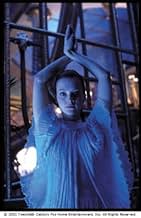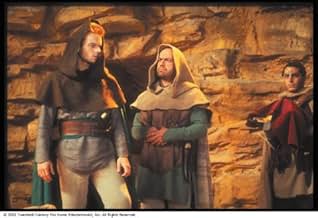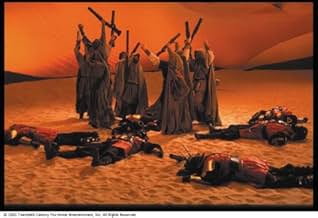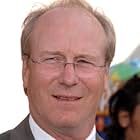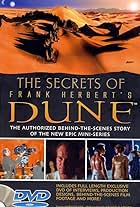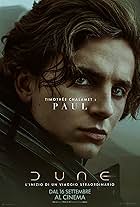Politica, tradimento, lussuria, avidità e la venuta di un Messia.Politica, tradimento, lussuria, avidità e la venuta di un Messia.Politica, tradimento, lussuria, avidità e la venuta di un Messia.
- Vincitore di 2 Primetime Emmy
- 9 vittorie e 9 candidature totali
Sfoglia gli episodi
Trama
Lo sapevi?
- QuizThe Mahdi statue at Sietch Tabr was inspired by the Buddha statues in Bamian, Afghanistan, which were later destroyed by the Taliban.
- BlooperThe computer generated "'thopters" have fans on the back wings to make them fly. The actual close-up models are missing these fans.
- Versioni alternativeThere exist four versions of this mini series:
- the original version presented to the Sci-Fi channel which runs ca. 280 minutes and was deemed unsuitable by Network execs/censors. This version was used everywhere else.
- the American TV version (ca. 265 min., see below)
- the UK version (see below)
- the Director's edition which adds ca. 6 minutes to the original version (ca. 286 min., see below)
- ConnessioniFeatured in Troldspejlet: Episodio #25.11 (2001)
Recensione in evidenza
I was wondering if I needed to wait until viewing the entire mini-series version of Frank Herbert's seminal science fiction classic, but now having seen Part One, I know that won't be necessary.
How I wish there were some way to extract the charisma of the movie's cast, and somehow meld it with the production values and plotline of the new version. That way, fans of this sprawling allegorical tale could have the best of both worlds. Not that there aren't admirable things about both versions.
Where the magnificent photography of the late, great Freddie Francis served well David Lynch's more ethereal tendencies in the 1984 version, Vittorio Storaro's cleaner, clearer images for Harrison's miniseries could very well be a metaphorical reflection of the ever-expanding vision of its hero, young Paul Atreides (nee Paul Mu'ad D'ib.) The production design of both films is lavish, but where Lynch's film gave locations and accoutrements a more lived-in look, the mini's similar designs, though equally accurate by the novel's standards, reflect that antiseptic cleanliness that we are learning to recognize more and more with the advent of digital technology and its application to cinematic visual techniques.
With a few exceptions, the casting and therefore the subsequent performances are just as clean and clear-cut, dispensing with some of the character's humanity in exchange for the original's hystrionics of its more memorable characters.
Where Kenneth McMillan's unredeemably repulsive yet completely unforgettable Baron Harkonnen was the apex of pustulant, corpulent evil, Ian McNeice's version comes off as daintily perturbed, as if the most upsetting event in his worldview is not being served tea on time. William Hurt and Saskia Reeves capture the confident, manor-bred mantles of Duke Leto and the Lady Jessica accurately enough, but gone are the sorrowful grace of Jurgen Prochnow and the stunning Francesca Annis, whose relationship seemed tinged with the inescapable taint of a prophecy waiting to be fulfilled, and the damned, doomed parts they both played in its unfolding.
The rest of the cast, though gamely essaying their roles to the best of their ability, could hardly hope to match the powerhouse ensemble assembled by Italian mega-mogul Dino de Laurentis. For years, David Lynch was wrongfully assigned the blame for butchering his own film, when buffs everywhere know that he suffered through the ham-handed, studio-supervised editing of what should've been a landmark of science-fiction filmmaking, similar to what Terry Gilliam would endure at the same studio with BRAZIL.
Further insult was added to the injury when a four-hour cut was assembled by Universal for the TV version, which Lynch promptly removed his name from, (hence the traditional "Smithee" credit for direction, and the writing by "Judas Booth.")
While it is a splendid example of how CGI and other visual technological developments are making it possible for filmmakers to maintain accuracy and a truth to tell those stories it would've been impossible to film over a decade ago, (and for about half the cost), I for one do miss the star power and (at least) some of the remarkable acting in the Lynch version. I suspect where more money was spent on securing stars in '84 than for the sets and costume designs, the exact opposite is true for the new miniseries.
New and old fans of the tale should view and enjoy the latest version for the visuals, then go back and review the movie for the Lynchian touch, which in some odd but affecting ways came closer to Herbert's underlying messages of mysticism, miracles and seizing one's destiny than the Harrison version. In any case, you can come away with some elements of the best of both DUNE worlds.
How I wish there were some way to extract the charisma of the movie's cast, and somehow meld it with the production values and plotline of the new version. That way, fans of this sprawling allegorical tale could have the best of both worlds. Not that there aren't admirable things about both versions.
Where the magnificent photography of the late, great Freddie Francis served well David Lynch's more ethereal tendencies in the 1984 version, Vittorio Storaro's cleaner, clearer images for Harrison's miniseries could very well be a metaphorical reflection of the ever-expanding vision of its hero, young Paul Atreides (nee Paul Mu'ad D'ib.) The production design of both films is lavish, but where Lynch's film gave locations and accoutrements a more lived-in look, the mini's similar designs, though equally accurate by the novel's standards, reflect that antiseptic cleanliness that we are learning to recognize more and more with the advent of digital technology and its application to cinematic visual techniques.
With a few exceptions, the casting and therefore the subsequent performances are just as clean and clear-cut, dispensing with some of the character's humanity in exchange for the original's hystrionics of its more memorable characters.
Where Kenneth McMillan's unredeemably repulsive yet completely unforgettable Baron Harkonnen was the apex of pustulant, corpulent evil, Ian McNeice's version comes off as daintily perturbed, as if the most upsetting event in his worldview is not being served tea on time. William Hurt and Saskia Reeves capture the confident, manor-bred mantles of Duke Leto and the Lady Jessica accurately enough, but gone are the sorrowful grace of Jurgen Prochnow and the stunning Francesca Annis, whose relationship seemed tinged with the inescapable taint of a prophecy waiting to be fulfilled, and the damned, doomed parts they both played in its unfolding.
The rest of the cast, though gamely essaying their roles to the best of their ability, could hardly hope to match the powerhouse ensemble assembled by Italian mega-mogul Dino de Laurentis. For years, David Lynch was wrongfully assigned the blame for butchering his own film, when buffs everywhere know that he suffered through the ham-handed, studio-supervised editing of what should've been a landmark of science-fiction filmmaking, similar to what Terry Gilliam would endure at the same studio with BRAZIL.
Further insult was added to the injury when a four-hour cut was assembled by Universal for the TV version, which Lynch promptly removed his name from, (hence the traditional "Smithee" credit for direction, and the writing by "Judas Booth.")
While it is a splendid example of how CGI and other visual technological developments are making it possible for filmmakers to maintain accuracy and a truth to tell those stories it would've been impossible to film over a decade ago, (and for about half the cost), I for one do miss the star power and (at least) some of the remarkable acting in the Lynch version. I suspect where more money was spent on securing stars in '84 than for the sets and costume designs, the exact opposite is true for the new miniseries.
New and old fans of the tale should view and enjoy the latest version for the visuals, then go back and review the movie for the Lynchian touch, which in some odd but affecting ways came closer to Herbert's underlying messages of mysticism, miracles and seizing one's destiny than the Harrison version. In any case, you can come away with some elements of the best of both DUNE worlds.
I più visti
Accedi per valutare e creare un elenco di titoli salvati per ottenere consigli personalizzati
Dettagli
- Data di uscita
- Paesi di origine
- Siti ufficiali
- Lingue
- Celebre anche come
- Dune
- Luoghi delle riprese
- Aziende produttrici
- Vedi altri crediti dell’azienda su IMDbPro
- Tempo di esecuzione4 ore 25 minuti
- Mix di suoni
Contribuisci a questa pagina
Suggerisci una modifica o aggiungi i contenuti mancanti








